Varicose veins is a disease characterized by a change in the condition of the veins in the legs with restricted blood flow. If the shape is neglected, the vessels bulge, which leads to swelling and pain of the extremities (under load), as well as aesthetic discomfort. Surgical removal of damaged veins is effective at this stage.
Indications for an operation for varicose veins
An operation for varicose veins can only be performed if there are indications for the removal of blood vessels:
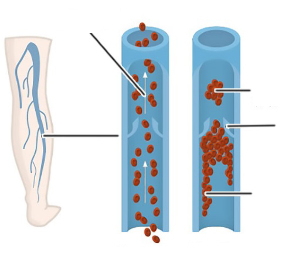
- Varicose veins have affected most of the vein;
- severe pain and swelling of the legs during physical exertion that interferes with a normal lifestyle;
- the formation of open wounds and ulcers against the background of the development of the disease. It is dangerous to apply a secondary infection.
- violation of the permeability of blood through the vessels, often accompanied by convulsions;
- clear development of vascular necrosis;
- pathological change in the veins, accompanied by their expansion and protrusion. The change is dangerous due to trauma to the vessels and also causes aesthetic discomfort;
- blood clots in the veins.
Surgical interventions are only permissible in the case of advanced forms of varicose veins and in the absence of dynamism with conservative treatment.
Absolute and relative contraindications for surgical interventions
An operation to remove leg veins in varicose veins is not only performed if there are indications, but also without contraindications:
| Absolute prohibitions of the operation | List of relative prohibitions |
| Stable high blood pressure | Presence of infectious diseases |
| Regular jumps in the blood pressure index | Dermatological diseases of the skin on the legs |
| Chronic heart disease | Inflammatory processes in the body, including blood vessels |
| Advanced age after 70 | The recovery phase after other surgical interventions |
| Presence of cancer | Chemotherapy |
| Diabetes mellitus and severe asthma | Severe soft tissue injury from trauma |
| Thinning and fragility of blood vessels | Liver and kidney diseases in the acute stage |
| Patients with limited leg mobility (paralysis) or bedridden patients | bleeding disorder or anemia |
| Varicose veins in the last stage | Taking hormones, antibiotics or other sharp drugs |
| Complicated leg fractures (with damage to blood vessels and nerve endings) | Overweight |
| Allergic reaction to drugs used during the operation | Rejection of the patient from the operation |
When carrying a child, there may also be a violation of the state of the veins in the legs. More often, after childbirth, the pathology clears up on its own. In the presence of contraindications, surgical intervention is dangerous with a deterioration in the patient's condition and even with a fatal outcome.
Phlebectomy
Phlebectomy is a surgical procedure used to remove damaged veins and restore normal blood flow to deep veins.
Anatomical importance, major surgery technique to remove veins
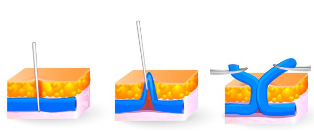
The circulatory system in the legs consists of a deep vein and many branches of superficial veins that affect varicose veins. Changes in vascular activity develop due to a dysfunction of the valves. During the normal functioning of the vessels, the valves are closed, which means that blood flow is only ensured in one direction.
In the veins of those affected by varicose veins, the valves do not close. As a result, the blood can move in both directions, which leads to impaired blood flow with congestion and protrusion of the veins.
In order to restore the blood supply to the extremity, the affected vein (with reverse blood flow) must be removed, ie a phlebectomy must be performed. Before the operation, the patient is prepared (conduct tests, scan the condition of the veins, determine the general condition of the patient).
If there are no contraindications, specialists perform a surgical procedure that consists of the following steps:
- The affected vessel is accessed through a small incision (in the groin or in the popliteal, depending on the location of the vein). Next, the damaged vessel is tied off from a deep vein to block blood flow.
- An incision is made near the varicose vein. The probe is used to separate the vessel from the muscle tissue, the lymphatic system and the small capillaries. The damaged vein is removed through a tube or with a hook.
- The capillaries are treated to prevent bleeding.
- If damaged capillaries form spider veins, these are removed.
- At the end, cosmetic stitches, a disinfectant bandage and an elastic bandage are applied.
The operation is performed under general or local anesthesia. Depends on the size of the ship and its position.
Efficiency level
Surgical removal of veins is used at different stages in the development of varicose veins. The procedure is very effective (over 98%). The restoration of the blood circulation takes place in a short time.
Rehabilitation
The effectiveness of the procedure depends not only on the qualification of the surgeon, but also on compliance with the rules in the postoperative period.
After the phlebectomy you need:
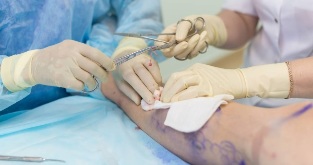
- Suture care for 7-14 days in a hospital;
- Compression stockings or elastic bandages are worn around the clock for 30 days.
- after 30 days, another 3 months, wear special underwear during the day
- Water procedures with washing the feet (where the operation was performed) are only possible after removing the stitches;
- During the recovery phase, saunas, baths and hot baths are prohibited.
- Painkillers after surgery are prescribed by a doctor. Self-selection is prohibited;
- Extra medicines are taken to prevent blood clots.
- taking medication to strengthen the walls of blood vessels (vitamins E and C);
- It is forbidden to stand / sit for long periods and wear high-heeled shoes and tight underwear.
- During the rest phase in the supine position, the legs should be above the body. Promotes the outflow of excess blood and reduces swelling;
- timely and gradually introduce physical activity to normalize blood flow (discussed with your doctor);
- Massages and physiotherapy are carried out with the approval of the treating specialist.
- Rejection of alcoholic beverages and nicotine. Alcohol provokes vasodilation, and tobacco, on the contrary, leads to their narrowing. These effects reduce the efficiency of the operation;
- If you are overweight, a low-calorie diet is prescribed.
If the rules are followed, a complete restoration of the function of the extremity is possible in 6 months
Endovenous coagulation with a laser
Surgery to remove veins in the legs with varicose veins using a laser is performed when it affects direct vessels with a diameter of at least 0. 02 cm and with a small number of capillaries. The procedure consists in the action of light waves on damaged vessels with their subsequent soldering and destruction.
Equipment
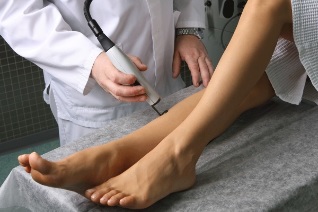
Laser coagulation of veins can be performed with three types of optical fibers:
| Type of optical fiber | Action description |
| End (classic) | This light guide generates radiation from the end, ie the vessel is sealed in front of it. The disadvantage is the formation of bruises and a painful feeling of tightness in the veins. Maximum vein diameter 0. 1 cm. |
| Radial (with painless radial light guide of the elves) | Light waves from the fiber form a circle that wraps around a vein in diameter. This allows veins of any size to be treated. It also minimizes the risk of hematoma formation and the development of swellings. |
| Of 3 types of radial fibers | Lasers with two rings of light are used to clear varicose veins. The first one prepares the vein for the procedure (elimination of excess fluid), the second circle solder the walls. For treatment, light guides are produced for fine and short veins as well as for large vessels. |
The choice of equipment is not only made by the patient, but also by the treating specialist for the condition of the ships.
Which veins can be used with the EVLK method
be removed?Before a phlebologist (a specialist who examines veins and clears varicose veins) selects EVLK, the properties of damaged vessels are determined. They must be straight and at least 2mm in diameter.
As a result, laser therapy can be used on the following vascular groups:
- small and large saphenous veins;
- saphenous secondary veins, located at least 5 mm from the surface of the epidermis;
- vessels that connect deep veins with superficial ones.
For other veins, therapy is only possible with phlebectomy.
Efficiency
The removal of veins using the EVLK method is possible with 3 types of optical fibers. The effectiveness of the treatment changes depending on the type of equipment. In an operation with a light guide, the effectiveness of the therapy is 94-96%. By operating with radial light guides, 100% of the varicose veins on the legs can be eliminated.
Preparation and implementation phases
If you want to remove varicose veins with EVLK, the patient should complete the following training:
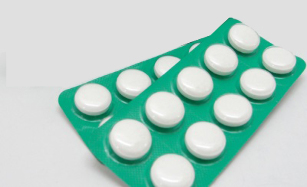
- discontinuation of hormone medication (if taken). As they can cause the development of thrombosis;
- The day before the procedure, blood thinners must be taken.
- Screening damaged veins to determine the extent of their damage;
- performs tests to rule out the presence of a hidden infection or inflammatory processes in the body. Blood clotting is also determined;
- The place of the procedure is thoroughly washed and shaved (without the use of cosmetics, only antibacterial soap is allowed).
Before the operation begins, the edges of the damaged vessels, the location of the laser / fiber insertion and the location of the branch capillaries are marked. With these markings you can solder the beginning and the end of the vein as well as the outlets of the capillaries. The process is carried out under the control of an ultrasound machine.
EVLK is manufactured in stages:
- Insertion of the catheter through a small puncture (the insertion point of the catheter is anesthetized with local anesthesia) into the marked area. The light guide moves along.
- Insertion of the light guide into the catheter and then advancement into the damaged area. It is carried out under ultrasound control on a monitor.
- Injection of an anesthetic to numb the vein and adjacent tissue.
- Advance of the "active" light guide through the damaged vein, followed by a delay where the capillaries branch off (to seal the exits and prevent bleeding).
- Removal of the laser through antiseptic treatment of the puncture site and application of an elastic bandage (or use of compression stockings).
After completing the procedure, the patient can leave the hospital immediately.
Features of rehabilitation
In order to restore the function of the injured limb and prevent the development of complications, you need to familiarize yourself with the nuances of rehabilitation after EVLK.
These are:
- After completing the procedure, it is recommended to walk the operated leg in a medical facility for an hour.
- ultrasound control of the treated vein is carried out for 2-3 days;
- Special underwear must be worn around the clock within 5 days (the type of stockings will be discussed with the treating specialist before the operation). Clothing must then be worn during the day within 45-60 days.
- knead your legs every day by walking for 60 minutes or more every day;
- Avoid overloading your legs (sitting or standing for long periods of time) and visit saunas or take a hot bath.
If the removal of varicose veins is still necessary, the procedures should not be performed before 7 days at the earliest.
The advantages of each method
An operation to remove leg veins in varicose veins has the following advantages, depending on the type of intervention:
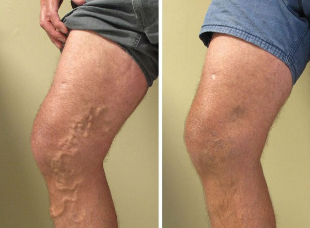
| Phlebectomy | EVLK |
| The incisions for the operation are approx. 5 mm, so that hardly any scars remain. | No pain during the procedure (under local anesthesia). General anesthesia is not required |
| Painlessness as the operation is performed under local anesthesia. Local anesthesia is used for the miniflebectomy. | EVLK is carried out under ultrasound control. The result is high precision and efficiency. |
| Low costs | Hematomas and pain at the surgical site are rare or mild. |
| Rapid restoration of the skin tone (absence of stars and purple-cyanotic hue of the epidermis) | The operation requires 1 puncture, so no stitches and no scars are required. |
| Short recovery time of approx. 30 days | Recovery period up to 5 days |
| Effective for all forms of varicose veins | After the operation, the patient can leave the clinic within 1 hour. |
| You can return to normal life in 24 hours. | |
| EVLK can be performed when the integrity of the epidermis is compromised by ulcers. | |
| The duration of the surgical intervention is no more than 40 minutes. | |
| EVLK can be performed on both legs in one day. A second operation is allowed on one leg after 7 days. |
The risk of infection during the procedure is minimal because the incision / puncture is small.
Complications after surgical interventions and laser vein operations
There is a risk of complications after vein removal by surgery or laser. Negative reactions can occur due to the low qualification of a specialist or due to rule violations during the rehabilitation phase. Possible complications of phlebectomy and endovenous coagulation.
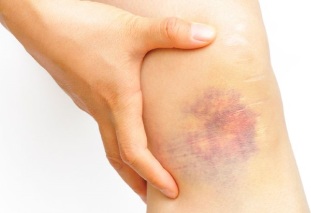
| Techniques for vein removal | Minor complications due to procedures | Main complications |
| Phlebectomy |
|
|
| Endovenous laser coagulation |
|
|
An allergic reaction to anesthetics may develop during both operations.
Measures to minimize complications
Surgery to remove leg veins with varicose veins is sometimes associated with the development of complications to prevent their occurrence.
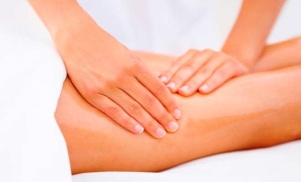
- Tests for allergic reactions to drugs used;
- Exclusion of infectious diseases and inflammatory processes in the body before the operation;
- Selection of proven clinics with highly qualified specialists and modern equipment;
- Compliance with the rules during the recovery period. Especially in compression underwear;
- adhere to the diet during the recovery phase (discussed by a specialist after the procedure). The amount of pure water in the diet increases, food is consumed in small portions, the diet is enriched with vitamins and minerals;
- feet rest during working hours;
- is examined after the operation to monitor the dynamics of limb recovery.
- to perform massages and participate in physiotherapy procedures to quickly restore blood flow.
If you find unacceptable deviations during this operation, you must contact the clinic immediately.
Comparison of the forecasts
With both methods of removing leg veins, the probability of a full recovery is over 95%, but excluding contraindications, observing the rules during the rehabilitation period and choosing a proven clinic. With surgical treatment, blood flow and the external condition of the legs are restored after 3 months, and with laser therapy, recovery is noted after 30 days.
In advanced forms, blood vessels are removed by surgical intervention. The method of treatment is determined not only by the patient's desire, but also by the presence of indications and contraindications to the procedure. The effectiveness of therapy depends on the qualification of the doctor and the implementation of the rules for foot care after surgery.

























